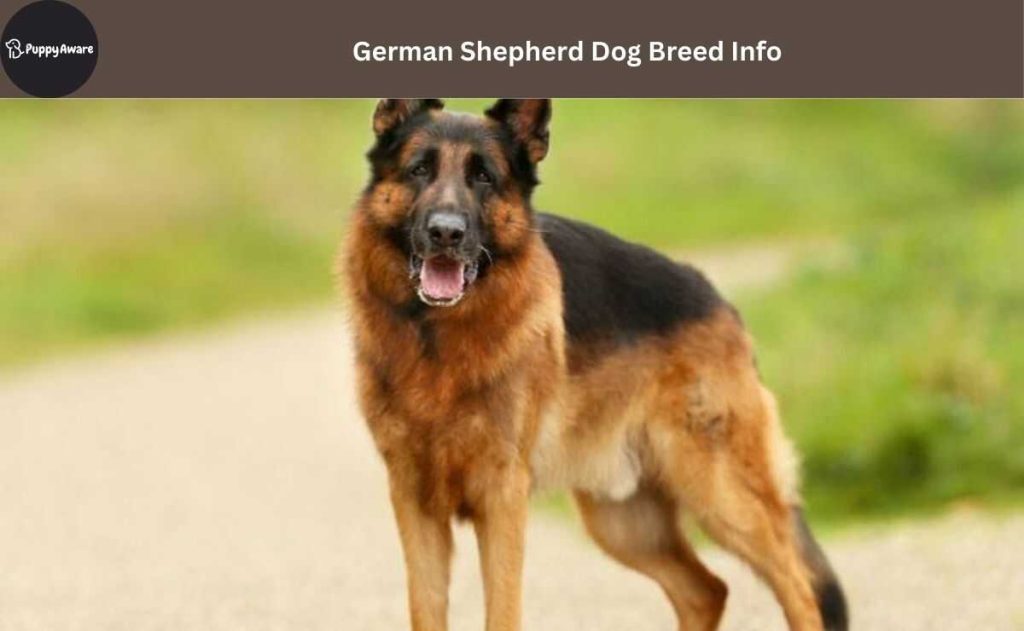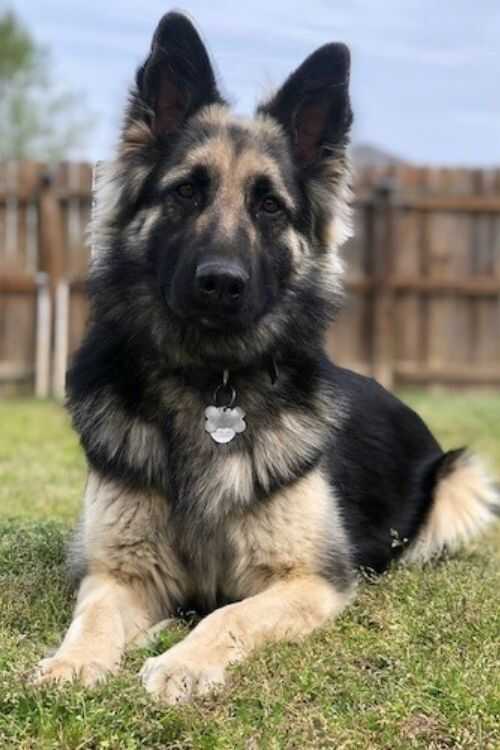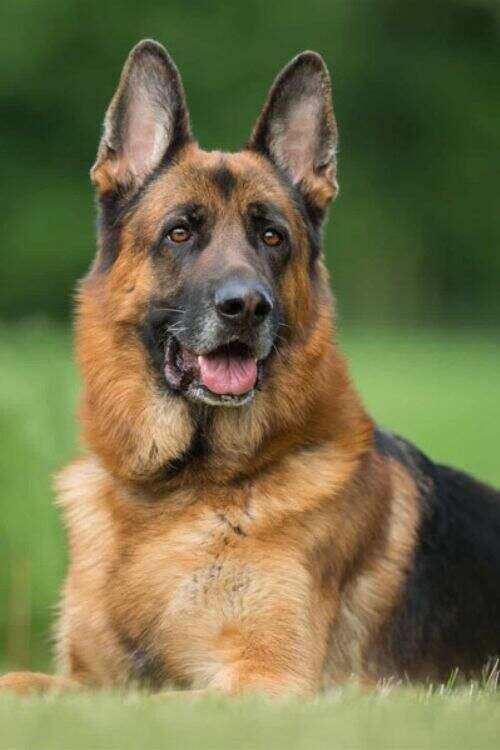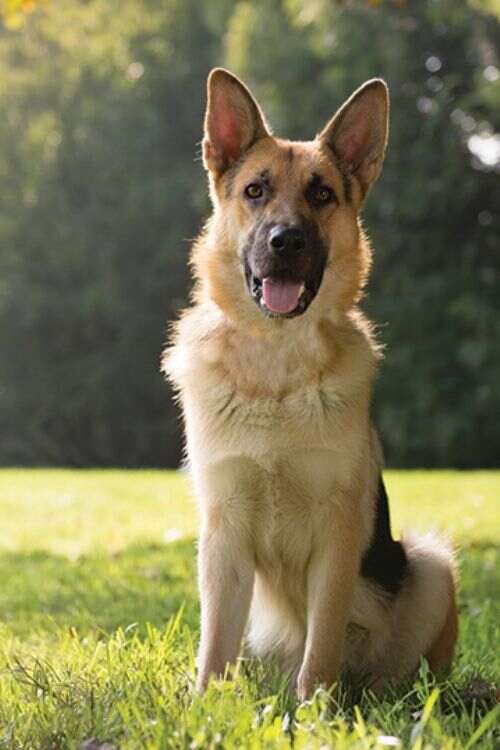The German Shepherd Dog (GSD) stands as one of the most recognizable and respected dog breeds globally, combining intelligence, versatility, and unwavering loyalty.
Originally developed in Germany during the late 19th century, these remarkable dogs have evolved from skilled sheep herders to become invaluable partners in military operations, law enforcement, search and rescue, and loving family companions.
German Shepherd Dog Breed Info : Germany’s Finest Working Dog

Key Breed Statistics
| Characteristic | Details |
|---|---|
| Height | Males: 24-26 inches (61-66 cm) Females: 22-24 inches (56-61 cm) |
| Weight | Males: 65-90 pounds (29-41 kg) Females: 50-70 pounds (23-32 kg) |
| Life Expectancy | 9-13 years |
| Coat Types | Stock coat (medium) Long coat (less common) |
| Recognition | AKC Recognition: 1908 FCI Group: 1, Section 1 |
| Purpose | Herding, Working, Protection |
Historical Background
Captain Max von Stephanitz, the breed’s founding father, established the first German Shepherd breed registry in 1899 after acquiring a dog named Horand von Grafrath. Von Stephanitz’s vision was to create the perfect working dog, emphasizing:
- Superior intelligence and trainability
- Strong work ethic and versatility
- Balanced temperament
- Athletic physique and endurance
- Natural protective instincts
Within decades, the breed gained international recognition, particularly after World War I, when returning soldiers spoke highly of these dogs’ courage and capabilities. German Shepherds served as:
- Military messengers
- Rescue dogs
- Guard dogs
- Medical assistance dogs
Modern Significance
Today, German Shepherds consistently rank among the top three most popular dog breeds in many countries. Their adaptability has led to their success in various roles:
- Police and military service dogs
- Search and rescue operations
- Guide dogs for the visually impaired
- Therapy and service animals
- Competitive dog sports
- Family guardians and companions
Physical Characteristics and Appearance

The German Shepherd’s noble appearance combines strength, agility, and balance, making them instantly recognizable worldwide. Their distinctive features reflect their working heritage and contribute to their exceptional functionality.
Structural Features and Proportions
| Body Part | Ideal Characteristics |
|---|---|
| Head | Proportional to body (40% of height at withers) |
| Muzzle | Strong, roughly equal to forehead length |
| Neck | Strong, muscular, set at 45° angle |
| Body Length | 10-17% longer than height |
| Back | Straight, strongly developed |
| Tail | Reaching at least to hock joint |
Coat Varieties and Colors
German Shepherds showcase two distinct coat types, each with its own characteristics:
Stock Coat (Standard)
- Dense outer coat with straight, harsh hair
- Thick undercoat for weather protection
- Shorter hair on head and legs
- Slightly longer hair on neck and thighs
Long Coat
- Longer outer coat with feathering
- Softer texture than stock coat
- Prominent ear tufts
- Pronounced feathering on legs and tail
Recognized Color Patterns
| Color Variety | Description | Show Recognition |
|---|---|---|
| Black and Tan | Most common, rich tan with black saddle | Fully recognized |
| Solid Black | Pure black throughout | Fully recognized |
| Sable | Range from light to dark, wolf-like | Fully recognized |
| Black and Red | Deep red markings instead of tan | Fully recognized |
| Black and Silver | Silver instead of tan markings | Fully recognized |
| White | Not recognized in most kennel clubs | Limited recognition |
| Blue | Dilute color, considered a fault | Not recognized |
| Liver | Brown variation, considered a fault | Not recognized |
Distinctive Physical Traits
The breed’s most notable physical characteristics include:
Ears
- Naturally upright when mature
- Large, pointed, and highly mobile
- Essential for their exceptional hearing capabilities
Eyes
- Medium-sized, almond-shaped
- Dark in color
- Alert, intelligent expression
- Never protruding
Skeletal Structure
- Strong, but not heavy bone structure
- Well-sprung ribs
- Deep chest reaching to elbow
- Straight, parallel legs
Movement
- Flowing, ground-covering gait
- Single-tracking at faster speeds
- Efficient, tireless movement
- Strong drive from hindquarters
This detailed overview of their physical characteristics sets the foundation for understanding their capabilities and breed standards.
Temperament, Intelligence and Training

German Shepherds are renowned for their exceptional intelligence and working capabilities, ranking consistently among the top three most intelligent dog breeds worldwide.
Their mental characteristics make them both excellent working partners and devoted family companions.
Intelligence and Learning Capacity
Cognitive Abilities Assessment
| Capability | Rating (1-10) | Notable Features |
|---|---|---|
| Working Intelligence | 9.5 | Learns new commands in 5 repetitions or less |
| Problem-Solving | 9 | Excellent at finding solutions independently |
| Memory Retention | 9.5 | Remembers commands for life with proper reinforcement |
| Social Intelligence | 8.5 | Strong ability to read human emotions and intentions |
| Adaptability | 9 | Quick adjustment to new situations and environments |
Core Temperament Traits
The German Shepherd’s temperament combines several essential qualities:
Loyalty
- Forms deep bonds with family members
- Naturally protective of their household
- Excellent guardian instincts without aggression
Confidence
- Self-assured in most situations
- Calm and composed under pressure
- Neither timid nor aggressive when properly bred
Work Ethic
- Strong desire to have a job or purpose
- High drive to please their handler
- Excellent focus and concentration
Social Nature
- Good with family children when properly socialized
- Reserved but not aggressive with strangers
- Generally good with other pets if raised together
Training Requirements and Recommendations
Early Training Priorities
| Training Area | Start Age | Key Focus Points |
|---|---|---|
| Socialization | 8-16 weeks | Exposure to various people, animals, environments |
| Basic Obedience | 8-12 weeks | Sit, stay, come, leash walking |
| House Training | 8-12 weeks | Consistent schedule, positive reinforcement |
| Bite Inhibition | 8-20 weeks | Gentle mouth training, appropriate play |
| Advanced Commands | 16+ weeks | Complex tasks, specialized training |
Training Approaches
For optimal results, German Shepherds respond best to:
- Positive reinforcement techniques
- Clear, consistent commands
- Regular mental stimulation
- Structured training sessions
- Early socialization
- Ongoing education throughout life
Exercise and Mental Stimulation Needs
To maintain a well-balanced German Shepherd, provide:
Physical Exercise
- 1-2 hours daily of active exercise
- Mix of walking, running, and play
- Age-appropriate activity levels
- Structured exercise routines
Mental Stimulation
- Problem-solving toys and puzzles
- Training sessions
- Scent work activities
- Interactive play sessions
- Agility or obedience training
Health, Care and Maintenance

German Shepherds require dedicated care and attention to maintain their health and well-being. Understanding common health concerns and implementing proper care routines is essential for ensuring a long, healthy life.
Common Health Issues
Hereditary Health Concerns
| Condition | Prevalence | Symptoms | Prevention/Management |
|---|---|---|---|
| Hip Dysplasia | High | Lameness, difficulty rising | OFA screening, weight management |
| Elbow Dysplasia | Moderate | Front limb lameness | Genetic testing, controlled exercise |
| Degenerative Myelopathy | Moderate | Progressive rear weakness | Genetic testing, supportive care |
| Bloat (GDV) | High Risk | Distended abdomen, restlessness | Multiple small meals, limited exercise after eating |
| Von Willebrand’s Disease | Low | Excessive bleeding | Genetic testing, careful monitoring |
Preventive Health Care Schedule
Recommended Veterinary Care Timeline
| Age | Required Care | Frequency |
|---|---|---|
| 6-8 weeks | Initial vaccinations | Series of 3-4 visits |
| 12-16 weeks | Rabies vaccination | Once, then as required by law |
| 6 months | Spay/Neuter evaluation | One-time discussion |
| 1-7 years | Annual wellness exams | Yearly |
| 7+ years | Senior wellness exams | Twice yearly |
| All ages | Heartworm prevention | Monthly |
| All ages | Flea/tick prevention | Monthly or as needed |
Grooming Requirements
German Shepherds require regular grooming to maintain their coat and overall hygiene:
Brushing Schedule
- Stock coat: 2-3 times weekly
- Long coat: 3-4 times weekly
- Daily during shedding seasons
- Use appropriate brushing tools:
- Slicker brush
- Undercoat rake
- Metal comb
Bathing and General Care
- Bathe every 8-12 weeks
- Clean ears weekly
- Trim nails monthly
- Brush teeth 2-3 times weekly
- Check and clean eyes regularly
Nutrition and Feeding Guidelines
Daily Nutritional Requirements
| Age | Daily Calories | Protein % | Fat % | Feeding Frequency |
|---|---|---|---|---|
| Puppy (2-6 months) | 1400-2000 | 22-24% | 12-14% | 3-4 times daily |
| Puppy (6-12 months) | 1700-2200 | 22-24% | 12-14% | 2-3 times daily |
| Adult | 1700-2400 | 18-22% | 10-12% | 2 times daily |
| Senior | 1300-1800 | 18-20% | 8-10% | 2 times daily |
Important Dietary Considerations
- High-quality protein sources
- Appropriate calcium/phosphorus ratio
- Joint-supporting nutrients
- Age-specific formulations
- Proper portion control
- Fresh water always available
Exercise and Living Space Requirements
Daily Exercise Needs
| Activity Type | Duration | Frequency | Notes |
|---|---|---|---|
| Walking | 30-45 mins | 2x daily | Brisk pace |
| Play/Training | 20-30 mins | 2-3x daily | Mental stimulation |
| Free Running | 30 mins | 1x daily | Secure area required |
| Rest Periods | Various | Between activities | Prevent overexertion |
Things to Consider for Choosing a German Shepherd
Making the right choice when adding a German Shepherd to your family requires careful consideration of various factors. This section will help you make an informed decision and understand the long-term commitment involved.
Cost Considerations
Initial and Ongoing Expenses
| Expense Category | Estimated Cost Range | Frequency |
|---|---|---|
| Purchase/Adoption | $500-3,000 | One-time |
| Initial Medical Care | $200-500 | One-time |
| Annual Medical Care | $700-1,500 | Yearly |
| Food | $600-900 | Yearly |
| Grooming Supplies | $100-300 | Yearly |
| Training Classes | $500-1,500 | First year |
| Emergency Fund | $1,500-3,000 | Reserve |
Choosing a Reputable Breeder
Key Breeder Evaluation Criteria
Documentation and Testing
- Health clearances for both parents
- OFA hip and elbow certifications
- DNA testing for hereditary conditions
- Registration papers
- Health guarantee
Red Flags to Watch For
- Multiple litters available constantly
- Unwillingness to show facilities
- No health testing documentation
- Pressure to buy immediately
- Prices significantly below market
- No screening of potential buyers
Living Situation Assessment
Compatibility Checklist
| Factor | Ideal Requirements |
|---|---|
| Living Space | Minimum 1000 sq ft with yard |
| Fence Height | 6 feet minimum |
| Time Commitment | 2-3 hours daily for exercise/training |
| Family Structure | Active family, older children preferred |
| Other Pets | Early socialization required |
| Climate | Adaptable to most climates |
| Work Schedule | Regular schedule, limited alone time |
Alternative Options
Consider these alternatives to purchasing from a breeder:
Rescue Organizations
- Breed-specific rescues
- Lower initial costs
- Adult dogs available
- Known temperament
- Often already trained
German Shepherd Adoption Benefits
- Saves a life
- Lower cost
- Adult personality known
- Often house-trained
- Previous training
Conclusion
German Shepherds represent one of the most versatile and capable large dog breeds available today. Their combination of intelligence, loyalty, and adaptability makes them excellent companions for the right owners.
For those willing to invest the time, energy, and resources, German Shepherds offer unparalleled companionship and capability. Their versatility allows them to excel in numerous roles, from family protector to service animal, making them truly one of the most remarkable dog breeds in the world.
Also Read
